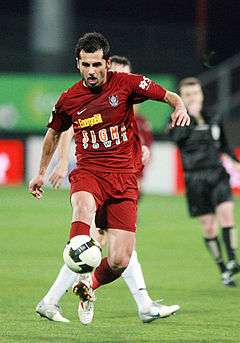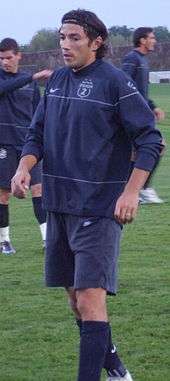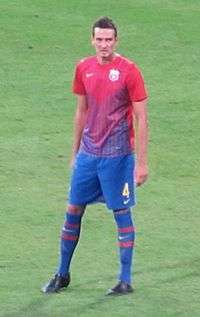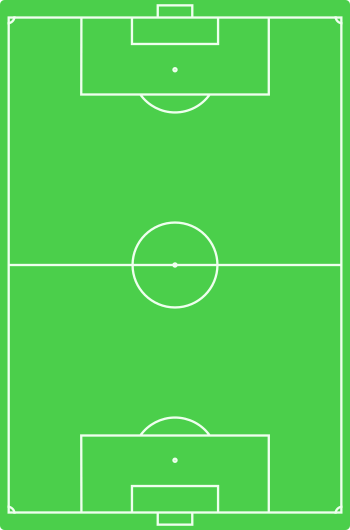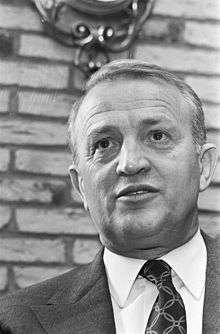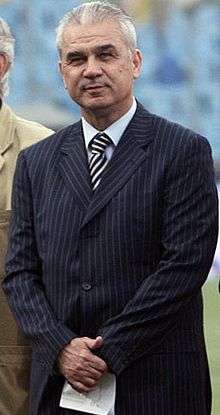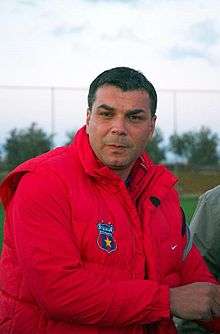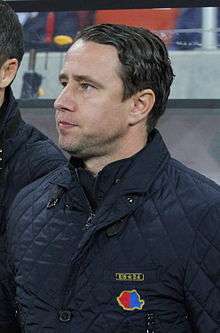FC Steaua București
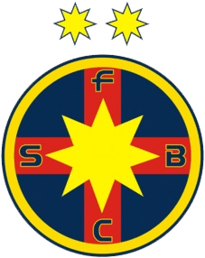 | |||
| Full name | Fotbal Club Steaua București | ||
|---|---|---|---|
| Nickname(s) |
Roș-Albaștrii (The Red and Blues) Militarii (The Army Men) Viteziștii (The Speedsters) | ||
| Short name | Steaua | ||
| Founded |
7 June 1947 as Asociația Sportivă a Armatei București | ||
| Ground | Arena Națională | ||
| Capacity | 55,635 | ||
| Owner | George Becali | ||
| President | Valeriu Argăseală | ||
| Manager | Laurențiu Reghecampf | ||
| League | Liga I | ||
| 2015–16 | Liga I, 2nd | ||
| Website | Club home page | ||
|
| |||
Fotbal Club Steaua București (Romanian pronunciation: [ˈste̯awa bukuˈreʃtʲ]) is a Romanian professional football club based in Bucharest. They currently compete in Liga I, the division in which they have spent their entire history. Domestically, Steaua have won Liga I 26 times, Cupa României 22 times, Cupa Ligii 2 times and Supercupa României 6 times – all competition records. In UEFA competitions they have won the European Cup and European Super Cup, both in 1986. They have also reached the European Cup final in 1989, the final of the Intercontinental Cup, quarter-finals of the European Cup Winners' Cup and the semi-finals of the UEFA Cup.
The club is historically known as the Romanian Army sports club, though the football department separated in 1998.
Steaua currently play their home games at Arena Națională, having moved there from their former home, the Ministry of National Defence-owned, Stadionul Ghencea. Initially, the club played in the colours of the Romanian tricolour – blue, yellow and red – but yellow soon lost its importance, and the team became associated with the red and blue colours. Since 2008 some away kits have begun to reintegrate the yellow colour. The club has a long-standing rivalry with Dinamo București, matches between the two being commonly referred to as "The Eternal Derby".
History
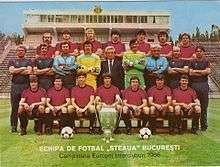

Steaua was founded on 7 June 1947, at the initiative of several officers of the Romanian Royal House. The establishment took place following a decree signed by General Mihail Lascăr, High Commander of the Romanian Royal Army. The club's first name was ASA București (Asociația Sportivă a Armatei București – Army Sports Association). It was formed as a sports society with seven initial sections, including football, coached by Coloman Braun-Bogdan.[1] ASA was renamed CSCA (Clubul Sportiv Central al Armatei – Central Sports Club of the Army) in 1948 and CCA (Casa Centrală a Armatei – Central House of the Army) in 1950.[1]
In 1949, CSCA won its first trophy, the Romanian Cup, defeating CSU Cluj 2–1 in the final. Under the name of CCA, the club managed to win three Championship titles in a row in 1951, 1952 and 1953, along with their first Championship-Cup Double in 1951. During the 1950s, the so-called CCA Golden Team became nationally famous.[2] In 1956, the national team of Romania, composed exclusively of CCA players, took on Yugoslavia in Belgrade and won 1–0. During the same year, CCA, coached by Ilie Savu, was the first Romanian team to enterprise a tournament in England where they achieved noteworthy results against the likes of Luton Town, Arsenal, Sheffield Wednesday and Wolverhampton Wanderers.[3]
At the end of 1961 CCA changed its name once again to CSA Steaua București (Clubul Sportiv al Armatei Steaua – Army Sports Club Steaua). The club's new name translates The Star and was adopted because of the presence of a red star, symbol of most East-European Army clubs, on their crest. A poor period of almost two decades followed in which the club claimed only three championships (1967–68, 1975–76, 1977–78). Instead, the team won nine national cup trophies, for which matter they gained the nickname of cup specialists.[4] Also during this period, on 9 April 1974, Steaua's current ground, Stadionul Ghencea, was inaugurated with a friendly match opposing OFK Beograd.[5]

Under the leadership of coaches Emerich Jenei and Anghel Iordănescu, Steaua had an impressive Championship run in the 1984–85 season, which they won after a six-year break. Subsequently, they were the first Romanian team to make it to a European Cup final, which they won in front of Barcelona on penalties (2–0 thanks to goalkeeper Helmuth Duckadam succeeding to save all four penalties taken by the Spaniards), after a goalless draw. Steaua therefore became the first Eastern-European team to claim the title of European champions. An additional European Super Cup was won in 1987 in front of Dynamo Kyiv. Steaua remained at the top of European football for the rest of the decade, managing one more European Cup semifinal in 1987–88 and one more European Cup final in 1989 (lost 4–0 to Milan). This happened next to their four additional national titles (1985–86, 1986–87, 1987–88, 1988–89) and four national cups (1984–85, 1986–87, 1987–88, 1988–89). Furthermore, from June 1986 to September 1989, Steaua ran a record 104-match undefeated streak in the championship, setting a world record for that time and a European one still standing.[6]
The Romanian Revolution led the country towards a free open market and, subsequently, several players of the 1980s team left for other clubs in the West. After a short pull-back, a quick recovery followed and Steaua managed a six consecutive championship streak between 1992–93 and 1997–98 to equalise the 1920s performance of Chinezul Timișoara[7] and also three more cups in 1995–96, 1996–97 and 1998–99. At international level, they also managed to make it to the UEFA Champions League group stage three years in a row between 1994–95 and 1996–97. In 1998, the football club separated from CSA Steaua and changed their name for the final time to FC Steaua București (Fotbal Club Steaua – Football Club Steaua),[8] being led by Romanian businessman Viorel Păunescu. Păunescu performed poorly as a president and soon the club was plunged into debt.[9] George Becali, another businessman, was offered the position of vice-president, in hope that he would invest money in the club. Becali eventually purchased the majority share in 2002 and turned the governing company public in January 2003.[10]
Because of his controversial character, he has been contested by the majority of Steaua fans.[11] The team qualified for the UEFA Cup group stage in the 2004–05 season and further on became the first Romanian team to make it to the European football spring since 1993 (also Steaua's performance). The next season, they reached the UEFA Cup semi-finals in 2005–06, where they were eliminated by Middlesbrough thanks to a last minute goal and thereafter qualified for the following UEFA Champions League seasons after a ten-year break. In the 2007–08 season Steaua have qualified again in the group stage of UEFA Champions League. Nationally, they gained two titles in 2004–05 and 2005–06 and the Romanian Super Cup in 2006, the latter being the club's 50th trophy in its 59-year history.[12]
In 2013, Steaua won its 24th national title, also reaching the UEFA Champions League group stage. They repeated the same performance next year, in 2014, winning the 25th championship.
Support

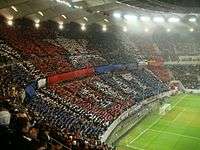
Steaua has the largest number of supporters of any team in Romania. A survey conducted in June 2007 suggested that the club accounts for approximately 42% of all Romanian football lovers, far greater than the teams ranked second and third, Dinamo București, with 12%, and Rapid București, with 9%.[13] The largest concentration of fans are in Bucharest, notably in areas adjacent to the arena, covering the whole southern half of Bucharest, a city geographically divided by the Dâmbovița River.[14] Also, the club has an important fan base inside the country, where several towns are renowned for counting vast majorities of Steaua supporters, and outside the borders, among Romanian emigrants.
The Steaua Ultras movement began in 1995, when the bases of Armata Ultra (AU), the first Ultras group from Bucharest (and second in Romania after Politehnica Timișoara's Commando Viola Ultra Curva Sud),[15] were set. The group quickly reached an impressive number of members, but, in 2001, they dissolved due to internal problems. Currently Steaua's supporters are divided into several groups, some of them being located at the Peluza Nord (North End) (Titan Boys, Nucleo, Insurgenții 1998, Skins 1996, Combat, Armata 47 Vest), while some other ones taking their place at the Peluza Sud (South End) (Vacarm, Glas, E.R.A., Hunters, Outlaws, Shadows, Roosters, T.K., Tinerii Sudisti). Several important groups such as Stil Ostil, Ultras, Banda Ultra' and South Boys retired from attending Steaua's matches due to the club's constant abuses towards them and, mainly, to the current ownership of Steaua.[16]
More recently, as of 2006, the supporters have formed their own official association, called AISS (Asociația Independentă a Suporterilor Steliști – Steaua Supporters' Independent Association). AISS was formed as a legal entity with its stated goals of protecting the interests and image of Steaua supporters, as well as identifying and promoting the club's perennial values.[17]
A heavy debated topic about the fans is the one related to racism. Stemmed from their rivalry with Rapid București, whose fans are often envisioned as Romani ethnics,[18] the issue degenerated on certain situations in several incidents between factions of supporters of Steaua and Rapid.[19] Also, the UEFA Champions League 2005–06 qualifying match against Shelbourne, resulted in a one-matchday pitch suspension for Steaua during the same European season, after racial chants were heard from the crowd.[20]
Lately, crowd turbulence has been one of the club's main problems. During the last three seasons, 11 Liga I matchday suspensions and one in the UEFA Cup have been dictated against the Ghencea-based club out of reasons such as crowd trouble, racial chants or torch lighting.
In 2009, UEFA ordered Steaua to play two home games of the Europa League behind closed doors due to their fans displaying racist banners in a second qualifying round match against Hungarian side Újpest.[21] Three further incidents occurred in the 2014–15 season, with the club fined and ordered to play further games in an empty stadium after displays of racist banners in games against Dynamo Kyiv, Ludogorets Razgrad and Strømsgodset.[22]
Stadium
 | |
| Location | Basarabia Blvd., Nr. 37-39 Sector 2, Bucharest, Romania |
|---|---|
| Owner | Municipality of Bucharest |
| Capacity | 55,634 |
| Field size | 105 m × 68 m (115 yd × 74 yd) |
| Construction | |
| Broke ground | 20 February 2008 |
| Opened | 6 September 2011 |
| Architect | Gerkan, Marg and Partners |
Steaua played its three first matches in history at the defunct Venus stadium. Opened in 1931, the venue had previously been in the property of Venus București, a club disbanded in 1949.[23] After the ground's demolition through order of the Communist regime, Steaua had played its home matches on either three of Bucharest's largest multi-use stadia, ANEF, Republicii (built in 1926 and put down in 1984 to make room for the erection of the Casa Poporului) and 23 August (built in 1953). Of these two, 23 August (current Național) was mostly used when two matches between Bucharest clubs were scheduled in the same matchday or for important European matches, while Republicii for regular matches inside the championship.
Steaua plays its home matches at the Stadionul Ghencea, a football stadium situated in South-Western Bucharest. Part of Complexul Sportiv Steaua, it was inaugurated on 9 April 1974 when Steaua played a friendly match against OFK Beograd,[5] at which time it was the first football-only stadium ever built in Communist Romania, with no track and field facilities.
The original capacity was 30,000 on benches. A general renovation occurred in 1991. This included installing seats, which dropped the capacity to 28,365,[24] inaugurating a floodlighting system and erecting a VIP personal box section.
After a second renovation, in 2006, which included refurbishing the turf, Ghencea[25] was able to host UEFA Champions League events, being a third category arena according to the UEFA classification system.[26] Lately, there have been talks for increasing the capacity to either 45,000 or 60,000.[27]
Romania was also a tenant. The first game played by the national team at Ghencea was in March 1977 against Turkey. 59 other games have been played ever since, the last one occurring in October 2006 against Belarus.[28] Also, several matches from the 1998 UEFA European Under-21 Football Championship, including the final, have been hosted by the arena.
The stadium, built through order of the Ministry of National Defence inside a former military base and was long used by CSA Steaua.
From 2011, Steaua have played the European games and its most important internal games on the newly constructed Arena Națională. From March 2015, only at Arena Națională.
Name, kit, crest and colours
| Period | Name |
|---|---|
| 1947–1948 | ASA București |
| 1948–1950 | CSCA București |
| 1950–1961 | CCA București |
| 1961–1998 | CSA Steaua București |
| 1998–2003 | AFC Steaua București |
| 2003– | FC Steaua București |
ASA București was founded by the Royal Army on 7 June 1947,[1] at which date the club had no official crest. During their first season, 1947–48, Steaua wore yellow and red striped shirts with blue shorts, to symbolize Romania's tricolour flag.[29] Starting with the following season and with the Army's change of identity from the Royal Army to the People's Army, the yellow was gradually given up, so that the official colours remained, up to this day, the red and the blue.
As communists assumed total control of the country on 30 December 1947,[30] the Royal Army was transformed into the People's Army and ASA automatically with it. Being inspired by the Red Army, the new Ministry of Defence decided to create a crest for the club, along with the change of name to CSCA, consisting in an A-labeled red star (symbol of the Red Army) on a blue disc.
Two years later, the change of name to CCA brought with it a new crest consisting of the same red star labeled CCA surrounded by a crown of laurel. The all-present star motif on the crest finally had its saying over the new name of Steaua as up 1961. It was opted for a badge which, redesigned, remains up to this day the club's symbol: the red and blue striped background with a golden star in the middle, to symbolize to Romanian tricolour flag. The shape for the emblem was redesigned in 1974, once the team moved to Stadionul Ghencea.
Steaua Bucureşti 1986 European Cup Final kit
|
Steaua Bucureşti 1986 Intercontinental Cup Final kit
|
Following the Romanian Revolution, the Army decided to break all links to the defunct communist regime, so, in 1991, CSA Steaua had a last change of crest with an eagle also present on the Ministry of Defence coat of arms and also on Romania's. As FC Steaua appeared in 1998, the club added two yellow stars on top of the CSA Steaua badge signifying its 20 titles of champions won, along with the Fotbal Club specification.
Steaua Bucureşti 1986 European Super Cup Final kit
2003 was the year of the last change of crest, decided by the new Board of Administration run by George Becali, which was a return to the old emblem of 1974–1991, redesigned with the two yellow stars on top. Steaua has never had a standard playing kit. However, the most widely used throughout time was the combination of red shirts, blue shorts and red socks. Other variants have been all-red, all-blue and also shirts in vertical red and blue stripes during the 1960s and 1970s. Other kit colours have very rarely been used. Exceptions were the 1986 European Cup Final in which Steaua wore, for the only time in their history, an all-white kit, the 1999–00 away kit (yellow and red), the 2005–06 third kit (yellow and black), the 2008–12 and 2014-16 away kit (all-yellow), the 2012-14 away kit ( all-sky blue or sky blue shirts with dark blue shorts and socks). For the 2016-2017 season, the away kit will be an all-white. Steaua Bucureşti 1989 European Cup Final kit
The Ministry of National Defense took Steaua to court in 2014, claiming that the Romanian Army were the rightful owners of the logo of Steaua Bucharest.[31] The Supreme Court found in the army's favour, and on 3 December 2014 stripped the football club of its badge.[31] Steaua were forced to play their next home game, against CSM Studențesc Iași, without it on the stadium scoreboard.[31] The club unveiled a new badge in January 2015, an eight-sided star containing the letters FCSB,[32] and issued a statement to the effect that they had reached an agreement with the Ministry of National Defense that would allow them to retain the name Steaua București and the colours.[33] Kit manufacturers and shirt sponsors
Steaua's kit is currently manufactured by Nike, who have held the contract since 2002, after a long partnership with Adidas.[34] First team shirt sponsors have been City Insurance since 2013.[35] Previous sponsors include Ford,[36] Castrol, Philips, CBS, Bancorex (initially BRCE), Dialog (currently Orange), BCR, RAFO, and CitiFinancial.[37] Gallery
Club rivalriesMain article: Eternal derby (Romania)
 Eternal Derby Scene Steaua's most important rivalry is the one against Dinamo București. Marele Derby (The Great Derby) has been the leading Romanian football encounter in the last 60 years, as Steaua and Dinamo are the two most successful football teams in the country. There have been a total of 156 matches played so far between Steaua and Dinamo, in Romanian League, Romanian Cup and also Romanian Super Cup, with the following results: Steaua 55 wins, Dinamo 54 wins and 47 draws.[38] With 44 titles won altogether (Steaua–26; Dinamo–18), the two clubs have won 16 of the last 23 seasons.[39] It is also a match between the former clubs of the Romanian Army (Steaua) and the Ministry of Internal Affairs (Dinamo). Several clashes between different factions of supporters have often occurred and still occur inside and outside the stadium. The heyday was reached before a match kick-off in 1997, when Dinamo's fans set a sector of Stadionul Ghencea's Peluza Sud, where they were assigned, on fire.[40] On 16 August 2016, during Steaua's UEFA Champions League play-off 0–5 loss against Manchester City, undercover Dinamo fans displayed a huge message saying "Only Dinamo Bucharest", which was labelled one of the biggest pranks in football history.[41] Between October 1991 and April 2000, Steaua counted 19 undefeated official matches in front of their rivals, both in the championship and the cup. Just as well, a period of 17 years and 7 months has been recorded in which Dinamo did not manage to win away against Steaua in the domestic league.[42] The second most important rivalry is the one with Rapid București. Several matches in the last years between Steaua and Rapid have also ended in serious clashes between fans.[19] Rivalry has become even fiercer since Steaua outpassed Rapid in an all-Romanian quarter final of the UEFA Cup 2005–06 season. The local sports newspapers said that the 2 teams were linked up in this quarter final by the line of the number 41 tram which links the Ghencea Stadium to the Valentin Stănescu Stadium. Milder and historical rivalries are also with non-Bucharest teams such as Universitatea Craiova, Politehnica Timișoara, Petrolul Ploiești, CFR Cluj, Universitatea Cluj and a recent one with Astra Giurgiu.[43] OwnershipSteaua has always been known as the club of the Romanian Army, who founded it in 1947 as a sports society.[1] The Army continues to own the society, called CSA Steaua București at the moment. The football department however, in order to comply with UEFA rules, separated and turned private in 1998, owned and financed by a non-profit organization called AFC Steaua București, chaired by businessman Viorel Păunescu.[44] George Becali In January 2003, the club turned public, under the leadership of investor and current politician George Becali, who had already purchased 51% of the society's shares and later on acquired the rest to become owner of the club. At present Becali has no official link to the club, as he gradually renounced his shares. However, the facts that the current shareholders, that include several nephews of his,[45] are people loyal to him and that he is still in charge of Steaua are obvious.[46] An unofficial explanation for this situation is represented by the heavy amount of unpaid taxes added up by the former governing company, AFC Steaua București, whose payment towards the tax authority was avoided this way by transferring its assets to the new-formed company, with the old association going on liquidation bankruptcy.[47] George Becali is currently a highly controversial person, whose involvement in the life of the club and the team has often been described as authoritarian and dictatorial by both the media and the fans.[48] Steaua in popular cultureAs Steaua is currently the most popular football team in Romania,[13] a good number of musicians or TV and film directors have inspired themselves from ideas linked to the Ghencea-based club. Popular reference, however, appeared only after the Romanian Revolution, as before, mass-media programmes were mostly being controlled by the former communist regime. The 2002 Romanian film Furia depicts scenes in which Steaua and Dinamo gangs of supporters are fighting on the streets after a direct match between the two sides.[49] Prima TV comedy show Mondenii often airs sketches parodying Steaua owner George Becali, the players and other representatives around the club.[50] Pro TV series La bloc aired an episode in which characters Nelu and Costel are displayed as representing Steaua in a parking lot match against two other neighbours representing Dinamo. Several other examples from music can be attributed as Steaua-related. Apart from club anthems played throughout time by Marcel Pavel, Bere Gratis, Gaz pe Foc, an album was released in 2006 as a compilation by Mircea Vintilă, Chicanos, Bogdan Dima and several other artists.[51] Delikt and Ultras are two former hip hop bands whose members ranked the defunct Armata Ultra' brigade and would always show up displaying fan materials. Also, Voltaj, in their song 'MSD2', make reference to the fans in the line Poți să fii câine sau poți fi stelist (You can be a dog[52] or you can be a Steaua fan).[53] One of the most famous pop-culture references about the club is the association with Scooter's song Maria, first sung spontaneously in 2003 by the fans in Peluza Nord after the team would score. Ever since, it has been adopted as an unofficial club anthem and is being played at the stadium at every match, sung together by the supporters. Nonetheless, the song is beginning to lose popularity, mainly because it has become too commercial and many fans do not feel bonded with it any more.[54] Rankings
Statistics and recordsSee also: FC Steaua București statistics
 Gheorghe Hagi Steaua currently boasts itself with the most impressive pedigree in Romania. With 62 seasons spent in Liga I, they are one of only two teams to have played only in the first national league, along with Dinamo București (61 seasons). At the same time, the club is the current record holder for the number of national championships (26), national cups (22), national super cups (6) and the national league cup (2). Between 1993 and 1998, their run of six consecutive national titles won equaled the one of Chinezul Timișoara from the 1920s. Internationally, they are the only Romanian club to have won continental trophies (the European Champions Cup in 1986 and the European Super Cup in 1986) and to have played in the final of the European Cup (in 1986 and 1989). For three years and three months (June 1986 – September 1989), Steaua counted a number of 104 unbeaten matches in the league, establishing, at that moment, a world record and a European one still standing.[57] Also inside the national league, they counted 112 matches between November 1989 and August 1996 of invincibility at Stadionul Ghencea in Liga I. Their run of 17 straight wins in 1988 is another record, equal to the one held by Dinamo as of one year later.[58] Tudorel Stoica is the player with the most appearances for Steaua in Liga I, a record unlikely to be broken in the nearby future, as none of the current players have entered the top 10 so far. The club's all-time top scorer in the league is Anghel Iordănescu with 146 goals, a record that also looks solid, out of the same reason as above-mentioned. Other records are currently owned by former players such as Dorinel Munteanu (most national caps – 134) or Gheorghe Hagi (most goals scored for Romania – 35; most appearances of a Romanian player in the European cups – 93).[59] European record1986 European Cup Final starting lineup. Main article: FC Steaua București in European football
Including away match with Zürich
HonoursDomestically, Steaua have won Liga I 26 times, Cupa României 22 times, Cupa Ligii 2 times and Supercupa României 6 times. In UEFA competitions they have won the European Cup and European Super Cup, both in 1986. They have also reached the European Cup final in 1989, the final of the Intercontinental Cup in 1986, quarter-finals of the European Cup Winners' Cup in 1972, 1993 and the semi-finals of European Cup in 1988 and the UEFA Cup in 2006. DomesticLeague
Cups
European
Worldwide
PlayersFirst-team squadNote: Flags indicate national team as defined under FIFA eligibility rules. Players may hold more than one non-FIFA nationality.
Out on loanNote: Flags indicate national team as defined under FIFA eligibility rules. Players may hold more than one non-FIFA nationality.
Club officialsBoard of directors
Current technical staff
Notable players throughout historyFor a list of the club's most important players throughout time, see List of FC Steaua București players.
Appearances and goals adds from Steaua's official book.
(*) Still playing for Steaua Notable managersMain article: List of FC Steaua București managers
The following managers have all won at least one major trophy with Steaua București:[66]
Notes: References
External links
|





